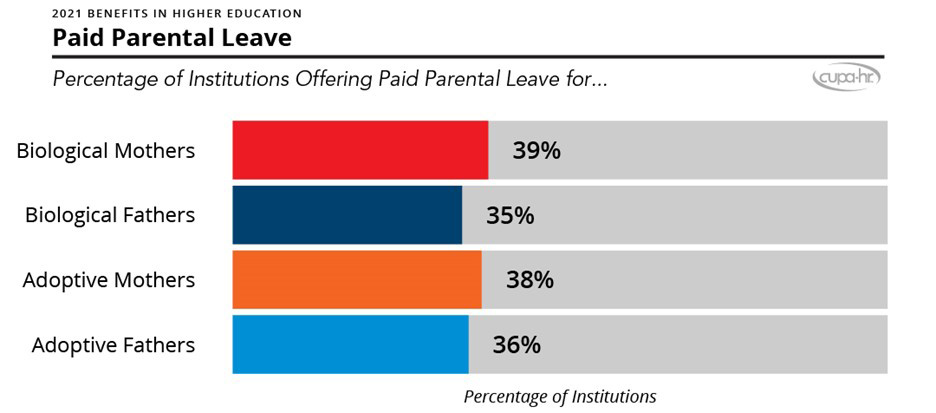2021 Benefits Report Examines Higher Ed Parental Leave Practices and More
According to the CUPA-HR 2021 Benefits in Higher Education Annual Report, fewer than 40 percent of higher ed institutions offer paid parental leave to new parents. The recently released report examines the benefits offered to higher ed employees, including healthcare plans, wellness programs, paid time off, tuition benefits and retirement.

For institutions that offer it, paid parental leave is offered in addition to vacation and sick time.
Also notable regarding paid leave, exempt employees receive more paid time off (PTO) than non-exempt employees, and the number of days off differs by type of PTO plan. New employees at institutions with plans that separate vacation and sick leave receive more total PTO days (27 days for exempt employees, 22 days for non-exempt employees) than employees at institutions with combined plans (22 days for exempt employees, 20 days for non-exempt employees). Eighty-five percent of higher ed institutions offer separate vacation and sick leave.
Other Key Findings
- Most (55 percent) institutions offer their full-time employees a choice between two healthcare plan types. The most common healthcare plan combination (offered by 37 percent of institutions) is a 2-plan combination of a Preferred Provider Organization (PPO) plan and High Deductible Health (HDH) plan.
- Institutions are more likely to offer healthcare benefits to staff and faculty retirees under 65 than those who are 65 and older and thus eligible for Medicare.
- Most institutions already have (62 percent) or will soon have (25 percent) a formal wellness program.
- More than half of institutions (58 percent) offer some form of short-term disability leave. Short-term disability leave is more common at private institutions than at public institutions.
- Institutions are slightly more likely to offer tuition benefits to unmarried same-sex partners (42 percent) than unmarried opposite-sex partners (37 percent).
- The 403(b) plan is the most popular retirement plan for both private institutions (where 96 percent offer it) and public institutions (where 97 percent offer it).
To learn more about the Benefits in Higher Education Annual Report, read the overview. Detailed information is available in the full report.
A total of 349 institutions completed the survey reporting on all benefits. Because this data was collected with an effective date of January 1, 2021, this report offers an overview of the current state of benefit offerings in higher education after the arrival of the COVID-19 pandemic. Additional analyses that highlight changes to benefits over the past year will be released on the CUPA-HR website.


